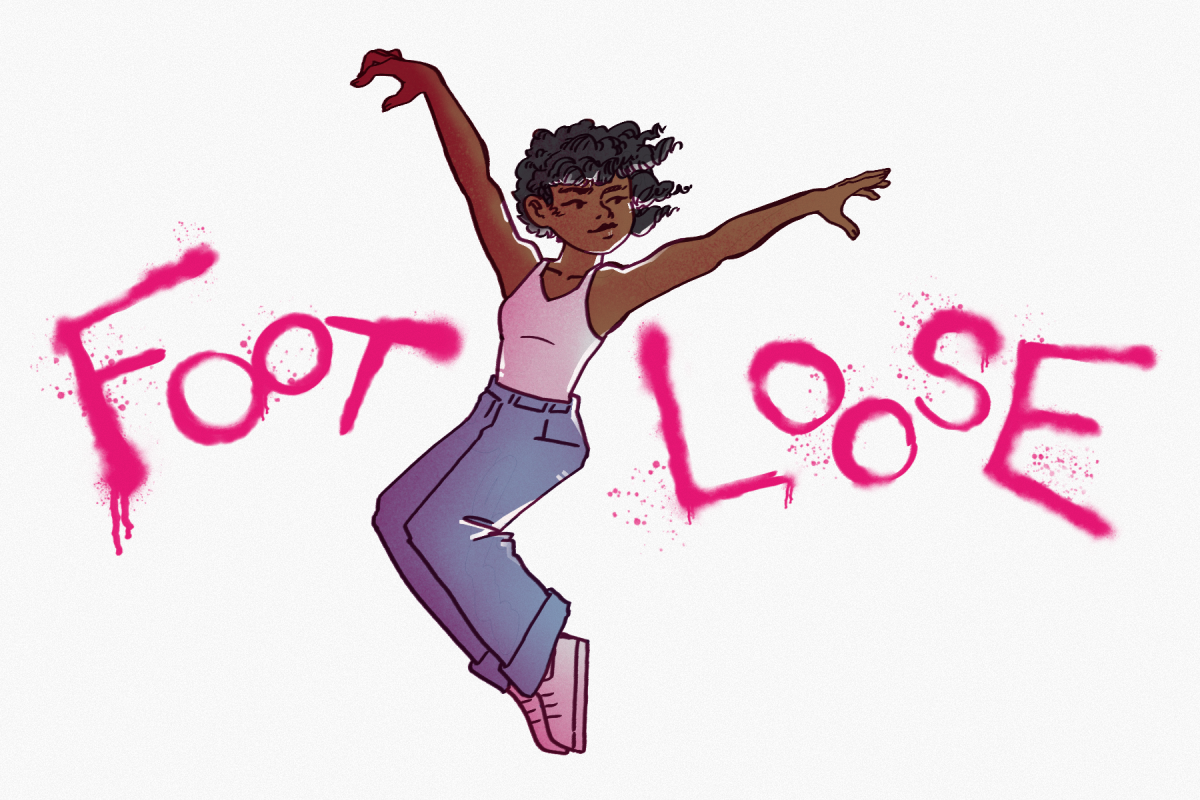
Allen Chen
On April 12, the curtains opened for the closing night of Muir Musical’s production of “Footloose: The Musical,” concluding its two-weekend run. Even though the production didn’t fully commit to a modern retelling, it was still a fun and enjoyable watch.
Based on the classic ‘80s film with the same name, “Footloose: The Musical” follows Ren McCormack, a dance-loving teen from Chicago who moves to the small town of Bomont. There, he discovers that dancing has been banned by the dictatorial Reverend Shaw Moore and sets out to rally the town’s youth against the law, all while falling in love with Moore’s rebellious daughter Ariel. When it was adapted for Broadway in the ‘90s — a full decade later — the writing transcended the film’s dated perspective to give the story a new life on the big stage.
Muir Musical followed this revisionist tradition, adapting elements of “Footloose: The Musical” for the UC San Diego audience. In the production we saw, the story was grounded in our present-day cultural and political climate. Beyond making references to ChatGPT, Heelys, and the current meme sensation “chicken jockey,” it also addressed attacks on queerness and the defunding of humanities programs across the country.
In her director’s note, fourth-year Olivia Rouss asks, “At its core, ‘Footloose’ has always been about liberation, and what is queerness if not the pursuit of joy in the face of fear?” This is a bold claim to make, and Muir Musical fulfilled it — but only in part.
The soundtrack boasted an array of beloved ‘80s tunes alongside various original songs made specifically for the Broadway production — an entertaining but occasionally jarring pairing. The performances clearly illustrated the joy and technique permeating the entirety of this production. The vocals were impressive, and the onstage band provided skilled melodic support. Although the show wasn’t too dance-intensive, its choreography was still engaging and well-executed, with the cast occasionally busting out some major moves onstage — splits galore!
A year after their rendition of the antagonistic, egotistical Shakespeare in last year’s “Something Rotten,” Nio Russell fully flexed their acting range with a nearly antithetical performance of the optimistic yet sardonic Ren. Other standout performances included Melanie Jimenez as Rusty, who channeled the soul of every ‘80s pop diva in “Let’s Hear It for the Boy,” and Emyr Ortiz as Willard, who — despite a microphone malfunction — stole the stage. These actors were more than just their singing chops; their well-placed humor kept the audience engaged and entertained.
Just as striking as the vocal performances, spray-painted backdrops and suspended neon signs were major eye-catchers, especially in contrast to the rest of the relatively simple set and props. In a unique creative decision by the Muir Musical production team, each sign lit up in correspondence to the characters and locations it represented and the main focus of the scene. Colorful graffiti decorated four large panels of fabric framing the stage, bearing lively slogans such as “Be Gay Do Crime,” “Long Live the Lesbians,” “You are on Native Land,” and “Gender is a Construct.”
Despite their seemingly radical aesthetic, the slogans never truly amounted to anything. This performativity pointed to a larger thematic issue within Muir Musical’s “Footloose”: promises of progressive values that the production does not fully see through.
The musical’s frequent nods to queerness — painted queer messaging, lesbian flag capes, and enthusiastic duckwalking — unsuccessfully attempted to distract from the fact that the show itself lacked any explicitly queer characters or relationships. These winks and nudges, while entertaining, did not quite fulfill “Footloose’s” promise of a queer reimagining. But that begs a question that plagues more than just this show: How explicit does queer representation need to be for it to count as “real” representation?
The show’s outdated portrayal of abusive relationships is another example of its reluctance to be a truly contemporary retelling. There were three moments of explicit physical abuse in the show: Ren’s uncle slaps him after being fired from his job, Chuck — Ariel’s troublemaker boyfriend at the time — beats her, and Reverend Moore raises his hand to hit Ariel before Mrs. Moore intervenes. These actions were brushed over with no characters facing explicit consequences for their actions. Though the production inserted Minecraft references with ease, it missed a much more key revision by perpetuating the negligence in the original script.
However, there were many things that the Muir Musical did right. The production breathed new life into the classic; the show built on each character’s background and motives in a way the film did not and successfully highlights the women overlooked in the original story. Rouss’ queer overtures, despite their shortcomings, made for a more unique, compelling, and, most importantly, relevant tale than the film ever was.
Muir Musical’s “Footloose: The Musical” was two hours of lively, imperfect joy. What came across more than anything was the cast and crew’s passion for not just the show but also what they believed it stood for.
In her opening speech, Rouss asked the audience to welcome dance, among other things, into their lives. While this performance might not have had us completely cutting loose, you might just find us in the stands, shaking to the beat.